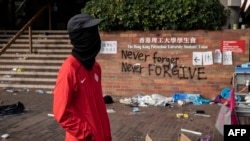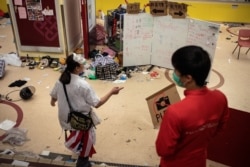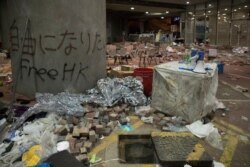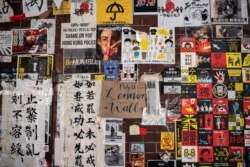When he left the house last week, Joseph, a 19-year-old Hong Kong college student, told his parents he was going to hang out with friends. That was only partly true.
In reality, Joseph was headed for the Hong Kong Polytechnic University, where he and a group of hundreds of other young people barricaded themselves on campus, blocked a major highway, and stockpiled homemade weapons in preparation to battle police.
Night after night last week, the urban campus become a battlefield, as police rained tear gas and rubber bullets on students, who responded with Molotov cocktails, bricks, and whatever else they could find.
Though Hong Kong has seen five months of protests, this kind of violence is new. The pro-democracy movement that had been marked by massive street rallies now risks being overtaken by a smaller group of hardcore students who have shown they are willing to go beyond peaceful demonstrations and engage in prolonged battles with police in their push for democratic reforms.
“I would definitely admit that we’re using a certain level of violence," says Joseph, who spoke via an encrypted messaging app. "But in order to protect the innocent protesters and create pressure on the government, a certain level of violence and power to fight back is necessary.”
In the minds of frontline protesters like Joseph, the violence is a last-ditch effort to preserve what is left of Hong Kong's freedoms before the semi-autonomous territory is fully taken over by China in 2047. Hong Kong authorities accuse the protesters of engaging in violence that is incompatible with democracy.
VOA spoke with about 10 young protesters, all of whom were at Polytechnic University over the past week. Though the standoff is largely over, a couple dozen holdouts remain on campus. Most have either surrendered to police or escaped. Some of the protesters face possible riot-related charges that could land them in jail for 10 years. VOA has used pseudonyms to protect their identity.
‘We tried peaceful demonstrations’
“We tried peaceful demonstrations, but the government didn’t listen," says Crystal, a Polytechnic student protester who has been on the run since leaving campus. She says she hasn't been able to sleep a full night in more than a week.
"I'm scared, really scared," she says.
Crystal wants to someday be an elementary school teacher, but for now she considers herself a revolutionary.
“Radical, I think, is a positive word for me, for us,” she says. “And most revolutions have violence.”
At this point, she's unsure of whether to stay in Hong Kong and fight, or seek political asylum in another country.
“This is my place. This is my home. I need to protect it,” she says. “And I know that in 2047, I will become an old woman. But what about the next generation? And the next generation? What they will become? Brainwashed? Everything fake, like China?”
Outmatched
Most of the frontline students that fought at Polytechnic are in their teens or twenties. Some are new protesters. Others are veterans of the 2014 Umbrella Movement, a student-led protest that unsuccessfully pushed for universal suffrage.
When it comes to brute strength, the students are outmatched, not only by the weapons of the Hong Kong police, but even more so by those of the Chinese People’s Liberation Army, the world’s largest military. The PLA has thousands of troops in Hong Kong and many more just across the border, though they have not yet left their barracks to confront the protesters.
“We deeply understand we are not able to win in hand to hand fighting,” says Joseph. “But still, we shouldn't be silent in the face of injustices.”
That is a common sentiment among frontline protesters, many of whom resent local and mainland Chinese media that accuse them of being naive children who are being pushed to the frontline by irresponsible adults. In reality, many of the more extreme protesters seem frequently self-aware, expressing a potentially dangerous mix of fatalism and determination.
In other words: they know they’ll likely lose, but they’re willing to fight anyway.
“We both know that it’s impossible to win, but only persistence can bring hope. If we never try, we know how this ends. We can't just say no no, impossible. Why not just try?” says Crystal.
Another student on campus, who carried a bow and arrow, and donned a military-style camouflage helmet, acknowledged that his weapons are no match for the forces he is up against.
“All the protesters are scared—because maybe we will die,” he said, speaking in front of a pile of mangled classroom desks that had been stacked up to form a barricade against police. “But we think if we don’t stand up this day, [then] all the freedom in Hong Kong will lose. There is no way for us to go back now.”
“All of us here know what we are doing,” said another frontline protester at Polytechnic, who spoke through a black gas mask that distorted his voice. “Because our demands are not being addressed, that’s why we are having to escalate and upgrade our actions so as to get the results from the government," he said.
Five demands
The latest round of protests erupted in June in opposition to an extradition bill. The proposal could have seen Hong Kongers tried in mainland China, where courts are controlled by the Communist Party and reports of torture and forced confessions are common.
Though authorities eventually abandoned the extradition bill, by then the protests had morphed into wider calls for democracy and opposition to the expanding influence of Beijing.
The protesters have adopted a list of five demands, including an investigation into police brutality, amnesty for arrested protesters, and direct elections for both the legislature and top executive.
But besides scrapping the extradition bill, Hong Kong authorities have refused to make concessions. Instead, as they have from the beginning, authorities dismiss the protests as riots.
“The rioters’ actions have far exceeded the call for democracy. They are now the enemy of the people,” Hong Kong’s Beijing-friendly Chief Executive Carrie Lam said earlier this month.
‘Off the rails’
Though the protesters appear to still have the support of a large segment of the Hong Kong public, some are worried about the direction of the protests.
“This movement has come off the rails and is really out of control,” says Steve Vickers, the former head of the Royal Hong Kong Police Criminal Intelligence Bureau. “The violent element, the sharp end of it, is really destroying the message that the rest of them had established through large demonstrations, which were peaceful.”
Vickers points to instances where protesters have vandalized public infrastructure, such as subway stations and highway toll booths. In other cases, pro-Beijing individuals or businesses have been attacked or set on fire.
“Demanding five things or we will burn down your railway stations on a regular basis is not going to end happily anywhere in the world,” says Vickers, who heads the SVA Risk Consultancy.
In recent weeks, there have also been several attacks on pro-democracy figures, including one politician who had his ear partially bitten off by a knife-wielding man outside a shopping mall.
Election a referendum?
Sunday's local elections could serve as a de facto referendum on the protest movement. Authorities had considered postponing the vote because of the violence, but they decided to move ahead, with a large police presence expected at polling stations.
“If the democrats really score a landslide victory, that will show very clearly that the public is in support of the movement, despite recent violence,” says Ma Ngok, a political scientist with the Chinese University of Hong Kong. “This will, I think ... [create] much more pressure for the Hong Kong government to respond to the demands of the protesters.”
Polls suggest a generational divide between younger Hong Kongers, who are resentful of increasing Chinese influence, and older Hong Kongers, who prefer stability even if it means a lesser degree of freedom.
For frontline protester Joseph, whose father is pro-Beijing, that means sneaking out of the house to attend violent protests.
“We’ve had a few strong arguments, but I’m pretty sure there are many families struggling with that,” he says.
Although Joseph says he has no plans to stop protesting, he doesn’t expect the violence to get much worse, for now.
“Keeping pressure on the government,” he says. “That is our first priority at the moment.”











